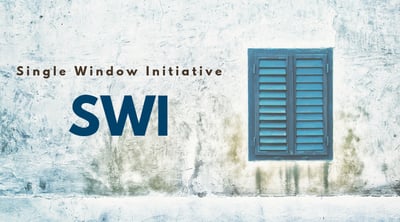Single Window Initiative (SWI) - Survival Guide #3: Importing Plant Cuttings
The new SWI landscape
The Single Window Initiative means several changes for importers:
 how you need to submit documentation is in flux;
how you need to submit documentation is in flux;- when that documentation is needed has changed; and
- which documentation is required is also shifting.
Our goal is to help you understand what is expected for the new “how, when, and what” of SWI requirements relating to the items you ship. These updates guide importers through specific commodities or categories of commodities, and the Participating Government Agencies (PGAs) that are affected.
How, when, and what
- Single Window Initiative requires all import documentation to be prepared and submitted before the shipment reaches customs.
- SWI is a new way of submitting documentation. All docs will be submitted using the Integrated Import Declaration (IID). Some of the requirements for how you submit are changing. For example: some documents that needed to be faxed now require an uploaded electronic image or just the document number.
- There may be changes to which documents are required under SWI.
- The launch date of SWI is still unknown, but it’s time to get proactive and adjust your workflow to ensure paperwork is ready before you ship.
Importing plant cuttings under SWI
This week, we guide you through two example commodities.
- Chrysanthemum, unrooted cuttings from the U.S., and
- Aloe vera, unrooted cuttings from Kenya.
Plant cuttings are regulated by:
CFIA: Canadian Food Inspection Agency
ECCC: Environment and Climate Change Canada - Wildlife Enforcement Directorate (WED)
Under SWI, the requirements for plant cuttings are the same as the legacy requirements.
Chrysanthemum, unrooted cuttings, unrooted plants
(including commercial houseplant produced in greenhouse and for resale)
CFIA requirements under SWI
- Full description: other live plants (including their roots), cuttings and slips, mushroom spawn
- End use, where the plants are going or what they are for: propagation
- Origin of the product: U.S.A., Florida
- Destination province of product: Alberta
- Phytosanitary Certificate: Materialized Document (image required)
- Plant Protection Import Permit: De-materialized document (no image)
ECCC requirements under SWI
- Compliance Statement indicating the product is not regulated under Wildlife Enforcement
- Scientific name of the plant: Chrysanthemum spp., Dendranthema spp., Leucanthemella serotina, Nipponanthemum nipponicum
- Intended end use: commercial, scientific, personal, educational, botanical garden
- Product category: specimens taken from the wild, plants artificially propagated
- Country of origin: USA, Florida
Aloe vera, unrooted cuttings, other unrooted plants
(commercial houseplant produced in a greenhouse and for resale)
CFIA requirements under SWI
- Full description: other live plants (including their roots), cuttings and slips, mushroom spawn
- End use, where the plants are going or what they are for: propagation
- Origin of the product: Kenya
- Phytosanitary Certificate: required as a Materialized Document (image required)
- Plant Protection Import Permit: required as a De-materialized document (no image)
ECCC requirements under SWI
- Compliance Statement indicating the product *is* regulated under Wildlife Enforcement
- Scientific name of plant: A. barbadensis Mill., Aloe indica Royle, Aloe perfoliata L. var. vera, A. vulgaris Lam
- Intended end use: commercial, scientific, personal, educational, botanical garden
- Product category: specimens taken from the wild, plants artificially propagated
- CITES permit (Convention on International Trade in Endangered Species of Wild Fauna and Flora): required as a Materialized Document (image required)
- CITES permit authorized name, address and contact information
Why importers need to know
Under the new SWI, it’s important that you understand which Participating Government Agencies (PGAs) are regulating your products. Some products are regulated by multiple PGAs, and the PGAs regulating your products may have changed under SWI. Additionally, each PGA and the CBSA can issue penalties for incorrect and missing documents. Understanding what information and documentation is needed for clearance will make the clearance process into Canada smoother and more efficient.
Our guidance for importing plants
Here are six clear action steps to ensure you get it right:
- Make sure to have the full description of the product (rooted/unrooted, with/without soil, in vitro, etc.).
- Know the specific, scientific botanical name of your product.
- Obtain a CFIA-issued Plant Protection Import Permit for the specific species of plants you are importing, if required.
- Obtain a Phytosanitary Certificate, if required.
- Review the phytosanitary requirements from the exporting country.
- Check to see if the species you’re importing is targeted by the Convention on International Trade in Endangered Species of Wild Fauna and Flora (CITES). If it is, you may require one or a combination of these documents: CITES Import permit, Export Permit, or Re-import permit.
For SWI, being proactive is your best strategy—gather all your information and documentation as far in advance as possible. Importers who know the requirements for the products they’re importing, and understand the new processes under SWI, will have a much smoother import experience.As you adjust to the new requirements and workflow of the Single Window Initiative, we're here to help. Our customs team is ready to help you understand the SWI and its new requirements for your commodities—contact us today!
SWI. It's what we do.

Latest Articles
- 7 ways Canadian importers reduce risk when ordering overseas
- Watch out for these extra charges on your freight bill
- Key differences between duty drawbacks and duty refunds for importers
- Mitigating container shortages and rising shipping prices for ocean imports
- How Canadian importers benefit from end use tariff codes and conditional relief
